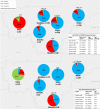Anopheles gambiae (s.l.) exhibit high intensity pyrethroid resistance throughout Southern and Central Mali (2016-2018): PBO or next generation LLINs may provide greater control
- PMID: 32384907
- PMCID: PMC7206711
- DOI: 10.1186/s13071-020-04100-7
Anopheles gambiae (s.l.) exhibit high intensity pyrethroid resistance throughout Southern and Central Mali (2016-2018): PBO or next generation LLINs may provide greater control
Abstract
Background: Millions of pyrethroid LLINs have been distributed in Mali during the past 20 years which, along with agricultural use, has increased the selection pressure on malaria vector populations. This study investigated pyrethroid resistance intensity and susceptible status of malaria vectors to alternative insecticides to guide choice of insecticides for LLINs and IRS for effective control of malaria vectors.
Methods: For 3 years between 2016 and 2018, susceptibility testing was conducted annually in 14-16 sites covering southern and central Mali. Anopheles gambiae (s.l.) were collected from larval sites and adult mosquitoes exposed in WHO tube tests to diagnostic doses of bendiocarb (0.1%) and pirimiphos-methyl (0.25%). Resistance intensity tests were conducted using CDC bottle bioassays (2016-2017) and WHO tube tests (2018) at 1×, 2×, 5×, and 10× the diagnostic concentration of permethrin, deltamethrin and alpha-cypermethrin. WHO tube tests were conducted with pre-exposure to the synergist PBO followed by permethrin or deltamethrin. Chlorfenapyr was tested in CDC bottle bioassays at 100 µg active ingredient per bottle and clothianidin at 2% in WHO tube tests. PCR was performed to identify species within the An. gambiae complex.
Results: In all sites An. gambiae (s.l.) showed high intensity resistance to permethrin and deltamethrin in CDC bottle bioassay tests in 2016 and 2017. In 2018, the WHO intensity tests resulted in survivors at all sites for permethrin, deltamethrin and alpha-cypermethrin when tested at 10× the diagnostic dose. Across all sites mean mortality was 33.7% with permethrin (0.75%) compared with 71.8% when pre-exposed to PBO (4%), representing a 2.13-fold increase in mortality. A similar trend was recorded for deltamethrin. There was susceptibility to pirimiphos-methyl, chlorfenapyr and clothianidin in all surveyed sites, including current IRS sites in Mopti Region. An. coluzzii was the primary species in 4 of 6 regions.
Conclusions: Widespread high intensity pyrethroid resistance was recorded during 2016-2018 and is likely to compromise the effectiveness of pyrethroid LLINs in Mali. PBO or chlorfenapyr LLINs should provide improved control of An. gambiae (s.l.). Clothianidin and pirimiphos-methyl insecticides are currently being used for IRS as part of a rotation strategy based on susceptibility being confirmed in this study.
Keywords: Anopheles gambiae; CDC bottle bioassay; Indoor residual spraying; Long-lasting insecticidal net; Mali; Piperonyl butoxide; Resistance intensity; Susceptibility test; Vector control; WHO tube test.
Conflict of interest statement
The authors declare that they have no competing interests.
Figures












References
-
- INSTAT: Enquête Démographique et de Santé 2018. Bamako, Mali et Rockville, Maryland, USA: Institut National de la Statistique (INSTAT), Cellule de Planification et de Statistique Secteur Santé Développement Social et Promotion de la Famille et, ICF International; 2019. https://www.dhsprogram.com/pubs/pdf/SR261/SR261.pdf. Accessed 20 Dec 2019.
-
- PMI: Presidentʼs Malaria Initiative; Mali Malaria Operational Plan (MOP) FY 2008. Washington DC, USA: Presidentʼs Malaria Initiative; 2008. https://www.pmi.gov/docs/default-source/default-document-library/malaria.... Accessed 10 May 2018.
-
- Wagman J, Gogue C, Tynuv K, Mihigo J, Bankineza E, Bah M, et al. An observational analysis of the impact of indoor residual spraying with non-pyrethroid insecticides on the incidence of malaria in Segou Region, Mali: 2012–2015. Malar J. 2018;17:19. doi: 10.1186/s12936-017-2168-2. - DOI - PMC - PubMed
-
- Programme National de Lutte contre le Paludisme (PNLP). Enquête sur les Indicateurs du Paludisme au Mali (EIPM) 2015. Bamako, Mali et Rockville, Maryland, USA: INSTAT, INFO-STAT et ICF International; 2016. https://www.dhsprogram.com/pubs/pdf/MIS24/MIS24.pdf. Accessed 10 Apr 2018.
-
- Lengeler C. Insecticide-treated bed nets and curtains for preventing malaria. Cochrane Database Syst Rev. 2004;2:CD000363. - PubMed
MeSH terms
Substances
LinkOut - more resources
Full Text Sources
Miscellaneous

